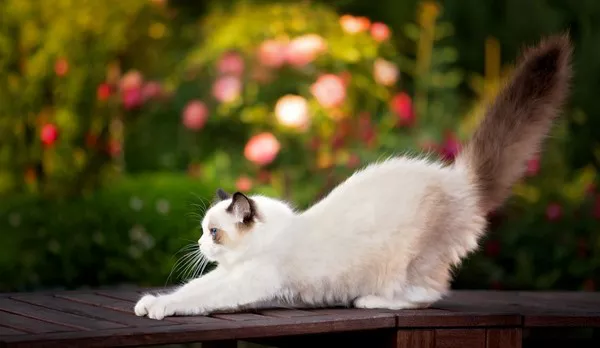Ragdoll cats are known for their docile temperament, striking blue eyes, and affectionate nature. These characteristics make them highly sought after as indoor pets. However, there is often a debate among cat owners and enthusiasts about whether these cats should be allowed to roam outdoors. This article will delve into the reasons why Ragdoll cats shouldn’t go outside, ensuring their safety and well-being.
Understanding the Ragdoll Temperament
Ragdolls are renowned for their calm and gentle nature. They are often described as “puppy-like” due to their loyalty and tendency to follow their owners around the house. Unlike many other cat breeds, Ragdolls are less likely to exhibit the hunting instincts typical of felines. This placid demeanor, while endearing, makes them particularly vulnerable in outdoor environments where agility, alertness, and survival instincts are crucial.
Safety Concerns
One of the primary reasons Ragdoll cats should not be allowed outside is safety. The world outside your home can be perilous for these gentle creatures. Here are some specific safety concerns:
Traffic Hazards
Ragdoll cats, with their relaxed nature, are not adept at navigating the dangers of traffic. Unlike feral or street-savvy cats, they lack the instincts to avoid cars, making them highly susceptible to accidents.
Predators
Depending on your location, there could be various predators that pose a threat to a Ragdoll cat. Dogs, coyotes, and even larger birds of prey could see a Ragdoll as an easy target due to their trusting and non-confrontational nature.
Exposure to Diseases
Outdoor environments expose cats to a myriad of diseases and parasites. Feline leukemia, FIV (feline immunodeficiency virus), and parasites like fleas and ticks are common in the wild. Ragdolls, being indoor cats, are typically not vaccinated against all the diseases prevalent in outdoor cats, making them particularly vulnerable.
Risk of Theft
Ragdolls are a popular breed due to their unique appearance and temperament, making them a target for theft. An unsupervised Ragdoll cat outdoors is at risk of being stolen, either for personal ownership or for illegal sale.
Behavioral Considerations
Ragdolls are not just physically ill-equipped for the outdoors; their behavior also makes them unsuitable for such environments.
Lack of Survival Skills
Unlike some other breeds, Ragdolls have not developed the necessary survival skills to fend for themselves outdoors. They are not great climbers or hunters and lack the aggressive defensive mechanisms needed to protect themselves.
Dependency on Human Companionship
Ragdolls thrive on human interaction and companionship. They are known to suffer from separation anxiety if left alone for long periods. Allowing them to roam outside could lead to stress and anxiety, especially if they get lost or are unable to find their way back home.
Nutritional Needs
Ragdolls have specific dietary requirements that are met through a controlled indoor diet. Outdoor cats often scavenge or hunt for food, which can lead to malnutrition or ingestion of harmful substances. Keeping Ragdolls indoors ensures they receive a balanced diet tailored to their needs.
See Also: How to Make Your Cat Healthy and Fat: A Comprehensive Guide
Environmental Hazards
The outdoor environment presents numerous hazards that can adversely affect a Ragdoll cat’s health and well-being.
Extreme Weather Conditions
Ragdolls are not built to withstand extreme weather conditions. Whether it’s the scorching heat of summer or the freezing cold of winter, these cats are more comfortable in a stable indoor climate. Exposure to extreme temperatures can lead to heatstroke, frostbite, and other health issues.
Poisonous Plants and Substances
Outdoor environments are replete with plants and substances that are toxic to cats. Lilies, for example, are highly toxic and can cause kidney failure if ingested. Additionally, antifreeze, pesticides, and other chemicals commonly found outdoors pose a significant risk.
Injury from Other Animals
Even if a Ragdoll cat doesn’t encounter predators, interactions with other cats or animals can lead to injuries. Fights with other cats, dogs, or wild animals can result in serious wounds and infections, further endangering their health.
Impact on Wildlife
Another important consideration is the impact of domestic cats on local wildlife. While Ragdolls may not be avid hunters, their presence outdoors can still disrupt local ecosystems.
Threat to Local Birds and Small Animals
Even the occasional hunt by a Ragdoll cat can have a detrimental effect on local bird and small animal populations. Domestic cats are known to be one of the leading causes of bird mortality in suburban and urban areas.
Environmental Imbalance
The introduction of a domestic cat into an outdoor environment can upset the local ecological balance. Native species may be displaced or stressed by the presence of a non-native predator, even one as seemingly benign as a Ragdoll.
Creating a Safe Indoor Environment
To ensure the health and happiness of a Ragdoll cat, it’s essential to create an enriching indoor environment that meets their physical and psychological needs.
Providing Stimulation
Indoor cats require mental and physical stimulation to prevent boredom and promote well-being. Invest in cat trees, scratching posts, and interactive toys to keep your Ragdoll engaged and active.
Window Perches and Safe Outdoor Access
While allowing full outdoor access is not advisable, providing a window perch can give your Ragdoll a safe way to experience the outdoors. Alternatively, consider building a “catio” or a secure outdoor enclosure where your cat can enjoy fresh air and sunshine without the associated risks.
Regular Veterinary Care
Ensure your Ragdoll receives regular veterinary check-ups and vaccinations. Indoor cats can still be susceptible to certain diseases, and regular vet visits will help keep your pet healthy and catch any potential issues early.
Quality Time and Social Interaction
Spend quality time with your Ragdoll. These cats crave human interaction, so regular playtime, petting, and even talking to them can strengthen your bond and keep them happy.
Conclusion
Ragdoll cats, with their gentle nature and dependence on human companionship, are best suited to indoor living. The myriad dangers and risks associated with outdoor environments—from traffic and predators to diseases and extreme weather—make it clear that these cats are safer and happier inside. By providing a stimulating and secure indoor environment, Ragdoll owners can ensure their pets lead a healthy, happy, and fulfilling life. Keeping your Ragdoll indoors is not just a matter of safety; it’s an essential aspect of responsible pet ownership.























